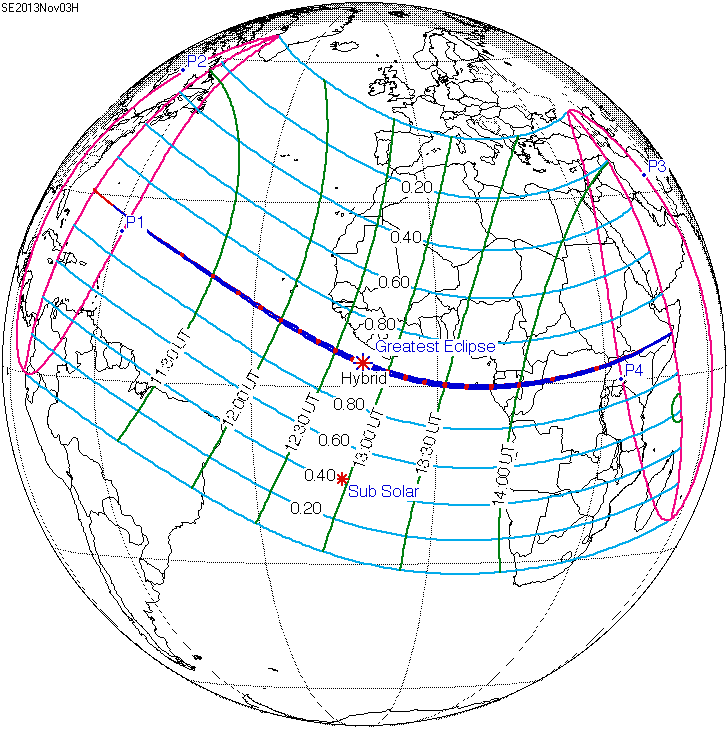Information about Eclipses (solar and Lunar), Occultations by SPACE (Science Popularisation Association of Communicators and Educators)
Monday, October 28, 2013
Rare Hybrid Solar Eclipse to Occur on Diwali day!!
Rare Hybrid Solar Eclipse to Occur on Diwali day!!
A total solar eclipse will occur on November 3, 2013. It is a hybrid eclipse (A hybrid eclipse (also called annular/total eclipse) shifts between a total and annular eclipse. At certain points on the surface of Earth it appears as a total eclipse, whereas at other points it appears as annular. Hybrid eclipses are comparatively rare) of the Sun.
This final eclipse of 2013 is the most interesting eclipse of the year. It is one of the rare hybrid or annular/total eclipses in which some sections of the path are annular while other parts are total. The duality comes about when the vertex of the Moon's umbral shadow falls on Earth's surface at some locations, but falls short of the Earth along other sections of the path. The unusual geometry is due to the curvature of Earth's surface that brings some geographic locations into the umbra while other positions are more distant and enter the antumbral rather than umbral shadow. In most cases, the central path begins annular, changes to total for the middle portion of the track, and reverts back to annular towards the end of the path.
However, November 3 eclipse is even more unique because the central path begins annular and ends total. Because hybrid eclipses occur near the vertex of the Moon's umbral/antumbral shadows, the central path is typically quite narrow.
The hybrid eclipse of 2013 is visible from within a thin corridor, which traverses the North Atlantic and equatorial Africa. A partial eclipse is seen within the much broader path of the Moon's penumbral shadow, which includes eastern North America, northern South America, southern Europe, the Middle East and Africa. When the shadow leaves earth, it will be Somalia where a 1 second total eclipse occurs at sunset!!
Totality will be visible from the northern Atlantic Ocean (east of Florida) to Africa (Gabon (landfall), R. Congo, DR Congo, Uganda), with maximum of 1 minute and 39 seconds visible from the Atlantic Ocean south of Ivory Coast and Ghana. This eclipse will not be visible at all from India.
PATH OF ECLIPSE
.
ANIMATION SHOWING THE ECLIPSE
Monday, October 14, 2013
Animation of the Penumbral Lunar Eclipse on 18-19 October, 2013
Courtesy http://shadowandsubstance.com/
Thursday, October 10, 2013
Penumbral Lunar Eclipse
A penumbral lunar eclipse will take place on night of October 18, 2013 (October 19th 2013 early morning for india), the last of three lunar eclipses in 2013.
It will be visible from the Americas (for the end), Europe, Africa, and most of Asia (the beginning of the eclipse will be visible in east and central Asia).
In India we would be seeing the eclipsed Moonset on the 19th morning and won't be able to see the whole duration of the eclipse.
Types of Lunar Eclipses
An eclipse of the moon occurs when the earth is in a direct line between the sun and the moon. The moon does not have any light of its own; instead, it reflects the sun's light. During a lunar eclipse, the moon is in the earth's shadow. It will often look dim and sometimes copper or orange in color. The lighter part of Earth's shadow is call the "penumbra" and the totally dark part is called the "umbra". If you see a chart that says the lunar eclipse is going to be penumbral, this means that the Moon will only pass through the lighter part of Earth's shadow. A partial lunar eclipse occurs when only part of the Moon passes through the umbra, or darkest part, of Earth's shadow. A penumbral lunar eclipse occurs when moon passes through penumbra, the lighter part of the shadow
.
Why lunar eclipses don't occur every month:
Since lunar eclipses occur always at full moon, it makes sense to ask why each full moon does not generate one. Eclipses are relatively rare because the plane in which the moon orbits around Earth is tilted 5 degrees compared to the plane of Earth's travels around the sun, a plane that astronomers call the ecliptic.
To visualize, think of two hula hoops — one big and one small — floating on the surface of a pool, and push the inner one down so that half of it is below the surface and half above. When the moon gets into the ecliptic — right at the surface of the pool — during its full phase, then a lunar eclipse occurs. (The word "ecliptic" stems from the word "eclipse.")
The geometry of any eclipse — the relative positions of the sun, Earth and moon — is eventually repeated during a set of complex cycles that each last just more than 18 years. This Saros cycle, as the whole thing is called, is behind the bunching of eclipses, too. Astronomers have figured it out and can predict eclipse timing and circumstances far into future.
Timings of the Eclipse:
Penumbral Eclipse Begins: 21:50:38 UT 18th October (03:20:38 IST 19th October)
Greatest Eclipse: 23:50:17 UT 18th October (05:20:17 IST 19th October)
Penumbral Eclipse Ends: 01:49:49 UT 18th October (07:19:49 IST 19th October)
Beginning and end of a penumbral eclipse are not visible to the eye. In fact, no shading can be detected until about 2/3 of the Moon's disk is immersed in the penumbra. This would put the period of nominal eclipse visibility from about 23:30 to 00:10 UT. Keep in mind that this is only an estimate. Atmospheric conditions and the observer's visual acuity are important factors to consider. An interesting exercise is to note when penumbral shading is first and last seen.
Subscribe to:
Posts (Atom)